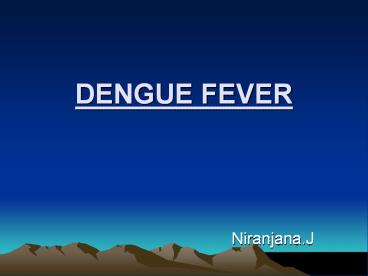DENGUE FEVER - PowerPoint PPT Presentation
Title:
DENGUE FEVER
Description:
DENGUE FEVER Niranjana.J DENGUE FEVER Syn: Break-bone Fever / Dandy Fever Acute febrile illness characterized by sudden onset of high fever severe pain in the bones ... – PowerPoint PPT presentation
Number of Views:463
Avg rating:3.0/5.0
Title: DENGUE FEVER
1
DENGUE FEVER
- Niranjana.J
2
DENGUE FEVER
- Syn Break-bone Fever / Dandy Fever
- Acute febrile illness characterized by
- sudden onset of high fever
- severe pain in the bones and joints,
lymphadenopathy - relative bradycardia and a characteristic
maculopapular reddish rash.
3
The Virology of Dengue Virus
- Group Group IV
- Family Flaviviridae
- Genus Flavivirus
- Species Dengue virus
- Man is the usual reservoir of infection
- Transmitted by female Aedes aegypti
4
Clinical Picture
- Classic dengue fever -5 to 8 days.
- Clinical picture
- High fever (biphasic pattern)
- Myalgia
- Arthralgia
- Rash syndrome
5
Rash in Dengue Fever
- The dengue rash-characteristically bright red
petechiae - Appears first on the lower limbs and the chest,in
some, spreads to cover most of the body. - It usually appears on the 3rd to 5th day.
- It disappears as the temperature falls
6
(No Transcript)
7
Symptoms of Dengue
- fever (saddle back fever)
- chills and rigor
- constant headaches
- bleeding from nose, mouth or gums
- orbital pain with painful movements of eyeballs
- vomiting and diarrhoea
8
Pathology
- Endothelial swelling of small blood vessels
- Perivascular edema
- Mononuclear cell infiltration
- Second attack of dengue leads to a fulminant
hemorrhagic disorder
9
Dengue cases reported from various states in
India
10
Dengue Hemorrhagic Fever
- Grade 1 Fever, constitutional symptoms
- Grade 2 Grade 1 spontaneous bleeding from
gums, skin and GIT - Grade 3 Grade 2 circulatory failure
- Grade 4Grade 2 profound shock are together
called as Dengue Shock Syndrome
11
WHO Definition of D.H.F
- The WHO definition of DHF has been in use since
1975 all the four criteria must be fulfilled - Criteria 1-
- Fever
- bladder problems
- constant headaches
- severe dizziness and loss of appetite.
- myalgia and arthralgia are absent unlike
classical dengue
12
- Criteria 2-
- Hemorrhagic tendency (positive tourniquet test,
spontaneous bruising, bleeding from mucosa,
petechiae on forehead and extremities)
13
- Criteria 3 4
- Thrombocytopenia (lt100,000 platelets per mm³ )
- Evidence of plasma leakage (hematocrit more than
20 higher than expected, or drop in haematocrit
of 20 or more from baseline)
14
Dengue Shock Syndrome
- Dengue shock syndrome is defined as dengue
hemorrhagic fever plus - Weak rapid pulse
- Narrow pulse pressure (less than 20 mm Hg)
- Cold, clammy skin and restlessness
- Severe abdominal pain, protracted vomiting,
marked change in temperature or change in mental
status
15
Complications
- Convulsions and respiratory failure
- Death can occur on the 4th or 5th day due to
gastrointestinal hemorrhage with hematemesis and
melena - Circulatory failure
- Non fatal cases recover rapidly
16
Laboratory Findings
- Thrombocytopenia with relative leukopenia
- Serologicals test -hemagglutination inhibition
and complement fixing antibodies demonstrated
7-14 days after the onset - ELISA test (for IgM antibodies)
- PCR available to confirm the diagnosis
17
Treatment
- Supportive therapy
- Increased oral fluid intake
- Platelet transfusion- if the platelet count drops
below 20,000 (rare cases) - Aspirin and NSAIDS must be avoided
- Emerging evidence suggests that ribavirin inhibit
dengue replication.In vivo studies,have not been
done yet
18
Preventive Measures
- Old tyres -dispose/cover
- Water storage-cover /add temphos
- Small container-clean up/bury/cover
- Every week have Dry Day
- Cleanup, drain, empty, or change all standing
water
19
Personal Prevention
- Mosquito repellant - during daytime.
- Flywire / screening on doors and windows.
- Mosquito coils or vapor mats.
- Mosquito nets for children/ elderly
- Use combination of the above measures
20
(No Transcript)































